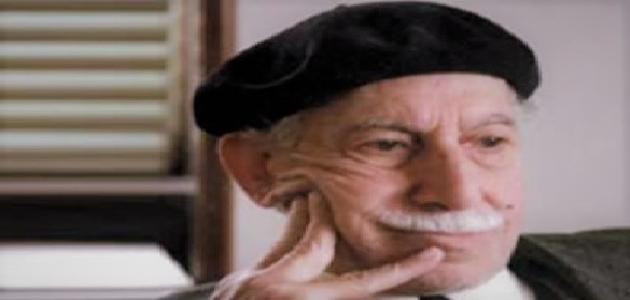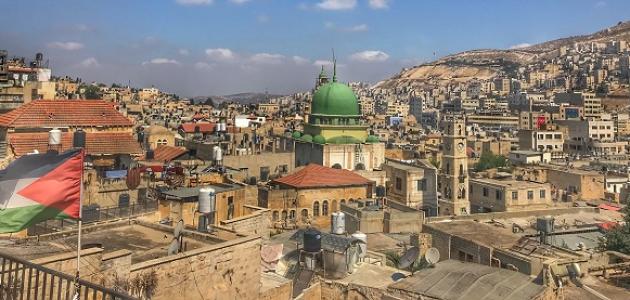Introducing Tawfiq Al-Hakim
Tawfiq al-Hakim is one of the most prominent pioneers of contemporary Arabic literature in general and Egypt in particular, and he is considered the founder of one of the most important theatrical arts in modern Egyptian literature, which is the art of drama. In his fame, Al-Hakim was also famous for his theatrical series containing many plays of a symbolic and dramatic nature. It is worth noting that Tawfiq al-Hakim had devoted his life to writing after his studies and work experience, in order to settle down and devote most of his time to the theater.
Birth of Tawfiq Al-Hakim
Tawfiq al-Hakim was born in the city of Alexandria in the summer of 1903 AD, and he lived with his father on a farm located in the Buhaira Governorate on the road to the city of Damanhour, and his parents were of different origins, and this may have been considered a reason for the ups and downs that Tawfiq went through. His mother was always trying to get him out of the mold in which he lived in a way that did not suit his soft mind as a child, so he moved from a state of activity and vitality that is accompanied by a flexible mind and imaginative thought that accompanies the mind to a state of isolation and self-closure. To then be a self-character for him.
Read also:Where was Mahmoud Darwish born?The birth of Tawfiq al-Hakim
Tawfiq al-Hakim grew up between two different parents in the dynasty. His father, Ismail al-Hakim, was from the peasant class. As for his mother, she is of Turkish origin, and she tried hard to make her husband join the urban class, and she had succeeded in that, and what helped in her success was her husband’s desire to enter the The ruling class of the Turks, and this made him cut off from his past and a past in his civilized present for a while, but this did not make him forget his instinct that he was educated on; He was always prevailing in the Turkish urban citizen, as he was struggling with two natures in it, the first that was built on it represented by the peasant class, and the other new one represented by the Turks, until this conflict moved from being an internal conflict to come out reflected in his marital life, and in this case Tawfiq al-Hakim arose, and he had what was The psychological effect on itself, which has a special character in it; This atmosphere was a way for him to have all his affairs in his imagination only, so that he was not like the rest of the children.
Tawfiq's inclinations were biased towards everything related to his psyche, such as its association with the fine arts, the most important of which was music, which was a major factor in making him integrated into the real world, and this was thanks to a musical takht associated with his parents' family, a musical group whose members used to stay with them in the summer, and through their wedding parties. Tawfiq would sit with them when eating and singing, and he would join them when he was six years old. The summer season was for him a season of compensation for his isolation during the remaining three seasons with his parents. The head of the musical takht had a special place with him. Because she was distinguished by her charming passion while singing, Tawfiq was always waiting to babysit her, until he was counting the months for her coming. It is worth noting that the conflict his father faced between his nature and the nature of his wife, in addition to her work, affected Tawfiq's life, which made him not like the aristocratic life prevailing in his family.
Read also:poetsEducation, work and marriage Tawfiq al-Hakim
Tawfiq al-Hakim's father used to travel a lot from one town to another for his work in the judiciary, but when he settled for a while in the city of Disouq, Tawfiq al-Hakim joined its only major school, which is the school of the Islamic Charity Association, and after a while his father moved to the city of Damanhur and then to the city of Alexandria, so he joined Al-Hakim attended Ras El-Tin Secondary School, then joined the Faculty of Law after his success in it, and continued his educational career, traveling to Europe to complete his master’s degree and then his doctorate, but he did not give his studies much importance, as he turned to art at the same time, especially theatrical art, so he returned to Egypt and worked within it. And outside it, and after a trip full of jobs, Al-Hakim returned from Paris to Egypt in 1960 AD because he wanted to be full-time for literature.
Tawfiq al-Hakim held many jobs in his life, which are as follows:
- Work in the mixed prosecution office in Alexandria, specifically from 1928 AD to 1929 AD.
- Worked in the private judiciary for a period of five years in different cities, and among the cities in which he moved: Tanta, Damanhour, Desouk, Faraskur, Kom Hamada, and Itay al-Baroud. In the countryside, memories of art and justice, justice and art.
- Director of the Investigations Department at the Ministry of Education.
- Director of Social Guidance at the Ministry of Social Affairs.
- Work in journalism in the daily news.
- General Manager of the Book House.
- Member of the Supreme Council for Arts, Literature and Social Sciences.
- Delegate of the United Arab Republic to UNESCO in 1959.
- President of the Egyptian Writers Union, after they elected him in 1982 AD.
Features of the personality of Tawfiq al-Hakim
Naguib Mahfouz spoke in his memoirs, describing Tawfiq al-Hakim as a man of morals, beautiful speech, and light-heartedness, in addition to his kindness. Al-Hakim married three daughters in one year, at a value equal to 15 thousand pounds, and that was a large amount at the time, and he also indicated that two of them were from his wife’s daughters to her ex-husband. It reached 30 thousand pounds, and it is worth noting that this amount went to her husband, who lost his business at the time, until he almost declared bankruptcy. Mahfouz also mentioned that Al-Hakim told him the story of the thirty thousand while he turned his palms laughing, indifferent to her loss.
Read also:Introducing the poet Ali Al-JumbalatiNaguib Mahfouz pointed out a shortcoming that he saw as cute from his point of view. Where he said that the writers of his generation used to, if they wanted to talk about a special matter, they would talk about it in the form of the common people. As for Al-Hakim, the general issues for him were turned into private ones. About his life and his family, which opposed his literary path for many hours, and others only listened to him, but despite al-Hakim's talk for long hours, he was not bored, as Mahfouz supported that by saying that they were accepting that for him, especially him and Zakaria Ahmed only, and what was mentioned in al-Hakim also was that he was not He asks about the conditions of his friends if they are absent, and that he is one of the personalities closed in on himself, as if he possesses a barrier between him and the outside world, and perhaps this personality made him immune to the tragedies he went through, such as the death of his wife and son Ismail in the prime of his youth.
Tawfiq al-Hakim's most prominent theatrical and literary works
Writer Hamid Allawi mentions in his book “The Theory of Theater according to Tawfiq al-Hakim” that al-Hakim was open to matters of theater during the secondary school stage. In her book “A Thousand and One Years on the Arab Theatre,” James Oldridge considered Al-Hakim as one of the most prominent playwrights in the world. It is worth noting that Al-Hakim added many plays to Arab libraries that contributed to their enrichment. It must be noted that his writing style was distinctive; He was able, through the inclusion of methods of dialogues and suspense, in presenting the characters, and this made a large number of playwrights in the Arab countries affected by him, and the following are the most prominent of his theatrical works:
A play in front of the box office
This play is represented by the fact that it is a dialogue between two characters under the terms “he” and “she”, and it is noted in this play that Tawfiq al-Hakim’s grace is made in finding places of depiction, descriptions, and dialogues, and the writers Ismail Adham and Ibrahim Naji mention in their book “Tawfiq al-Hakim” one of these dialogues that revolves between these two characters, for example, the character “he” asks the character “she” to write to him when she wants to see him, so she replies to him that his words are not important, and that she will not write to him, then he replies to her, pointing out that her act is nothing but the woman’s pride, and that despite Her love for writing would drive her, so she would reply to him, laughing, that he would wait for her, and he would answer her that he would do that, just as he would wait for her in the evening at Father Louis's restaurant after midnight.
The heavy guest play
This play is considered the first of Tawfiq al-Hakim’s plays, which he had written in 1919 AD, and he was concerned with establishing a small theater group for this play specifically for the purposes of performance and theatrical representation, when he established his own theater under the name “Tawfiq al-Hakim’s Theater”, which was one of the theaters that recently appeared in Egypt modern then.
The play of the new woman
Tawfiq al-Hakim wrote this play after the play “The Heavy Guest” in 1924 AD.
Pygmalion play
This play is one of the plays in the series of intellectual plays by Tawfiq al-Hakim, and it is the third in its arrangement in this series, after the play People of the Cave, which was written in 1933 AD in the first place, then the play Scheherazade, which he wrote in 1934 AD, and al-Hakim had written it in 1942 AD. It is worth noting that al-Hakim dealt in the introduction to the play with his discovery of a Greek myth, “Pygmalion”, by talking about two artistic paintings, and this was not the only Greek myth dealt with in this play, as he touched on the myth of “Galatia” and the myth of “fire of Kissus” as well. The following are the artistic paintings that he mentioned in the introduction to his play:
- An oil painting by the artist Jean Raoux, “Pygmalion and Galatea”, which is located in the Louvre Museum. This painting inspired Al-Hakim to write the play “Dream and Truth”.
- A cinematic panel dealing with the play Pygmalion, which was written by Bernard Shaw, an Irish writer, and this play was - in particular - al-Hakim's real motive for writing "The Pygmalion Play".
The play of the people of the cave
This play consists of four chapters, and goes back in its origin to the Qur’anic story “The Companions of the Cave”, and they are a group of individuals who fled from the persecution and fear that they were subjected to, so they settled in this cave and from here their story begins. This play was published in 1933 AD, and it deals with death issues in its scenes. , and the resurrection, and Al-Hakim reviews these topics in the form of people wrestling after their return to life, after they were in a deep sleep in the darkness of the cave.
The play of the people of art
Dar Al-Hilal published this play by Tawfiq Al-Hakim in 1934 AD, after Al-Hakim dealt with it in the form of three parts, which are, in order, the “worlds” piece, which was the first of the parts, then “The Piper”, and the last part is the “Poet” piece, and the following are the names of the pieces The three, mentioning the place and time of writing the piece:
- Realms piece: This piece was written in Paris in June of 1927 AD.
- Piper piece: This piece was composed in the city of Tanta in August 1930 AD.
- Poet's Piece: This piece was written in the city of Damanhour in May 1933 AD.
The play of the prayer of the angels
This play appeared for the first time before it became a theatrical work in Tawfiq al-Hakim’s book “Sultan of Darkness” in 1941 AD. It and four other short stories were mentioned in this book. In his book, al-Hakim dealt with the idea of confronting dictatorship, with his mention of civilization, and what it is exposed to. Dangers in his introduction, in addition to mentioning the opinions of the West to confirm what he says, most notably the ideas of “George Deha Mille” who dealt with the discussion of French civilization and the wise man was greatly influenced by it. The first and sixth scenes, as for the other chapters, they take place in unspecified places on earth, and they are also found in a series of plays by al-Hakim called “the diversified theater.” In this play, al-Hakim emphasized that peace stems from human instinct, and that despite the different races and colors of people, their goal remains. One is peace.
The play of the man who stood firm
This play is considered one of the plays of a social nature, so it was placed in a series of plays by al-Hakim under the name “Society Theater” with a number of other plays, and the number of them is twenty plays, and this series deals with some phenomena of Egyptian society and aspects related to people, their morals, and their natures, It is worth noting that this play presents the story of one of the employees as an ideal model for the upright person, who is chaste towards all the temptations of material life, as happens to employees in general, so the wise man shows the employee's firmness and lack of weakness despite his needs, in addition to showing the pressure exerted on him by his family to change his course. His path, his agreement, and his principles of life, as Al-Hakim shows how he stood upright behind what he learned from one of his elders at the beginning of his work in the judiciary.
The stories of the return of the spirit and a bird from the east
The play consists of two stories, “The Return of the Spirit” and “A Bird from the East”. Which was written by al-Hakim in 1933 in French, and then later written in the Egyptian Arabic language in circulation. The story of “Arsenyev” by the Russian novelist “Ivan Bunin”, and a sequel to this story was published after that in April 1927 AD after Al-Hakim audited it in the first months of 1938 AD, as the sequel was under the title “A Bird from the East”, which was written in fluent Arabic. Al-Hakim wrote the first chapters of it from the summer of 1937 AD until the winter of 1934 AD, and at the end of 1935 AD he wrote its last chapters.
Other works by Tawfiq al-Hakim
- Theatrical works:
- The play Scheherazade was written in 1934 AD.
- The play Muhammad, a dialogue biography written in 1936 AD.
- Praksa play, or called the problem of governance, which was written in 1939 AD.
- Suleiman Al-Hakim's play, written in 1943 AD.
- The play King Oedipus, which was written in 1949 AD.
- The play Isis was written in 1955 AD.
- The play The Deal was written in 1956 AD.
- The game of death was written in 1957.
- The play The Thorns of Peace was written in 1957 AD.
- The play Journey to Tomorrow was written in 1957.
- The Soft Hands play was written in 1959 AD.
- The play The Confused Sultan, written in 1960 AD.
- A play, O Tree Tree, written in 1962 AD.
- The play Food for Every Mouth was written in 1963.
- The play Sun of the Day, which was written in 1965 AD.
- The play The Fate of a Cockroach was written in 1966.
- Al-Worta play was written in 1966 AD.
- The Justice Council play was written in 1972 AD.
- The world play is a comic novel, which was written in 1974 AD.
- The donkey play was written in 1975 AD.
- Novels and short stories:
- The Enchanted Palace, and this work is shared with the writer Taha Hussein, and was written in 1936 AD.
- Diary of a deputy in the countryside, which was written in 1937 AD.
- People who wrote in 1938 AD.
- The Testament of Satan, written in 1938 AD.
- The Temple Dancer, written in 1939 AD.
- The Holy Ribat, written in 1944 AD.
- Justice and Art, written in 1953 AD.
- Youth Revolution, which was written in 1975 AD.
- Castle Bank, a theatrical novel, written in 1976 AD.
- Intellectual and literary works:
- Under the Sun of Thought, written in 1938 AD.
- My donkey said to me, written in 1938 AD.
- From the ivory tower, written in 1941 AD.
- Under the Green Lamp, written in 1942 AD.
- The Tree of Judgment, which was written in 1945 AD.
- The Art of Literature, written in 1952 AD.
- Reflections on politics, written in 1954 AD.
- Equivalence, written in 1955 AD.
- Our theatrical template, written in 1967 AD.
- The return of consciousness, written in 1975 AD.
- On the way to the return of consciousness, which was written in 1975 AD.
- Between Thought and Art, written in 1976 AD.
- Literature of life, written in 1976 AD.
- Challenges of the year 2000, written in 1980 AD.
- Equivalence in Islam, written in 1983 AD.
- Egypt between two eras, written in 1983 AD.
- Miscellaneous works:
- The Song of Songs, written in 1940 AD.
- Donkey Al-Hakim, which is a dialogue written by him in 1940 AD.
- The Sultan of Darkness, written in 1941 AD.
- Zahrat al-Omar, an autobiography written in 1954.
- Letters, written in 1954 AD.
- Spring and Autumn Journey, and this poetry was composed in 1964 AD.
- Al-Omar Prison, which is about memories of Tawfiq Al-Hakim written in 1964 AD.
- A journey between two eras, which are memories of Tawfiq al-Hakim written in 1972 AD.
- A conversation with the planet, which is a philosophical dialogue written in 1974 AD.
- Mukhtar Tafsir Al-Qurtubi, written in 1977 AD.
- Internal features, an interview with the author, written in 1982 AD.
Stages of the development of theatrical art according to Tawfiq al-Hakim
Tawfiq al-Hakim was distinguished by his many experiences with different literary currents, to the extent that students of his writing style made it difficult to classify his literary works. In this aspect, Dr. Mandour believes that al-Hakim worked on developing his style in theatrical art within three stages, namely:
- Stage life stage: It is the written stage of Tawfiq al-Hakim, which falls between the period (1943-1951 AD), in which al-Hakim’s plays were collected in two series, namely: “Society Theatre” and “Diversified Theatre”. These plays dealt with social and moral behaviors, and provided an opinion Al-Hakim's social life in it, and from Dr. Mandour's point of view, some of Al-Hakim's plays during this period would have been better to be within the mental theater, and he mentioned among them the play “If the youth knew.”
- Mental theater stage: This stage in Al-Hakim’s written life includes mental ideas that were discussed in a semantic manner, in addition to his adoption of abstraction in the theatrical text instead of material conflicts. Among the plays dealt with in this stage are “People of the Cave,” “Shaherazade,” and “Pygmalion.”
- Purpose theatrical stage: This stage deals with the theatrical texts authored by Tawfiq al-Hakim after 1952 AD, and it bears a new spirit and philosophy in al-Hakim's thought. He worked to confirm the idea of leadership in life by dropping it on a dramatic text, and this is unlike the previous one in showing the facts of life and criticizing its events, and from theatrical works Al-Hakim has at this stage the play “Soft Hands”, “The Deal”, and “The Thorns of Peace”.
Employing the myth in the literature of Tawfiq al-Hakim and its sources
The myth was employed in the literary art of the writer Tawfiq al-Hakim by making it a base on which he builds new myths from his imagination, in addition to using it as a semantic tool for what he wants to communicate in his fictional or fictional text, until the text became mixed with reality and imagination at the same time, just as the wise man was concerned with using it Many sources enriched his theatrical literature, as he drew inspiration from the Holy Qur’an, the story series “A Thousand and One Nights”, history books, as well as Greek and Pharaonic myths, and myths he drew from folklore, in addition to borrowing symbols from Indian, Norwegian, and Greek myths. When writing the fictional and nonfiction text, the following are some detailed sources:
Greek sources
The Greek myth is considered one of the most influential myths in European and Arab world literature, and all of their cultures. This is because the Greek civilization left a large number of literary, artistic, intellectual and scientific heritage, as it is considered one of the most valuable plays that it represents in mythology in the whole world. It is worth noting that Tawfiq al-Hakim used the Greek myth in many of his plays such as: the play “ King Oedipus”, the play “Pygmalion”, and the play “Braxa”, and it was indicated in the introduction to the book “The Classic Sources of Tawfiq Al-Hakim’s Theater” that he studied the Greek heritage after traveling to Paris to find a state of compatibility between the Greek and Arab theatre; Because he believes that there is no way to consolidate theatrical literature in contemporary Arabic literature except after reviewing the ancient Greek heritage; To blend it with Arab spiritual values, and support this by convincing the genius French writers and his teachers in French universities of the importance of returning to the study of the basis of European thought, as he was determined to study representational literature at the time, but he did not study the Greek language, but rather what he read from the works translated into French sufficed. To the fact that the enormous Greek mythological heritage is one of the courses of European thought.
Pharaonic sources
Tawfiq Al-Hakim was able to introduce the ancient Pharaonic myth into his literary works after searching for it to supply his literary imagination, and he had this in the ancient heritage of the Pharaohs, and what inspired Al-Hakim from this heritage is the myth of “Isis and Osiris”, which talks about the killing of the god “Osiris” by his brother named “ Set "to take his place in power after plotting a plot to kill him, so the legend tells that the wife of the god "Isis" searched for her husband's body until she reached her, but "Set" succeeded in stealing the body and cutting it, so that he distributed it to different parts of Egypt, then “Isis” insists on searching the body parts until she was able to collect them, so she became pregnant from her husband and gave birth to “Horus”, so that “Osiris” her husband would then become ruler of the kingdom of the dead, and when his son “Horus” grew up, he became competing with his uncle “Set” on the throne until he defeated him.
It is worth noting that al-Hakim was always searching for an Egyptian origin for all his literary works, until the end of this myth, and this is what the French researcher “Fontaine” sees in his doctoral thesis. It is also noted that al-Hakim took the character “Isis” specifically in this myth as a semantic symbol. In many of the characters in his novels and plays, including the novel “The Return of the Spirit”, represented by the “Sunni” character, and the “Prisca” character in the play “People of the Cave”.
Islamic stories
Tawfiq al-Hakim was inspired by the Qur’anic stories to write his literary works, as this was evident in his play “The People of the Cave.” In his memoirs, “The Flower of Life,” al-Hakim referred to the sources of his inspiration for this play during his conversation with his friend “Andre,” where he said: “I do not conceal from you that I wrote it for a while. I was under the influence of the Qur'an not only, but also under the influence of ancient Egypt. I used to read religious books, the Book of the Dead, the Torah, and the Four Gospels.” Jamal al-Ghitani mentions in his book “Tawfiq al-Hakim Remembers” that al-Hakim saw in European society that they were writing based on the heritage derived from Greek literature and coming from myths. To adopt their approach by referring to his true heritage, through which he can take historical themes for his literary works, and this is all represented by the Noble Qur’an and its stories.
Egyptian folklore
“Farouk Khurshid” defines folklore in his book “The Wonderful World of Popular Literature” as a set of verbal, artistic, and intellectual manifestations that are inherited by generations and peoples, and among its images are different ways of speaking and what remains of ancient myths. The wise man is a result of the environment in which the wise man lived since his childhood. He lived in a family dominated by the popular character and accompanied by the permanent folklore atmosphere, which made his imagination full of it, so Al-Hakim used folklore in his literary works, as he was inspired by a folk song, and other images of folklore, and it is worth noting that Al-Hakim used a popular loyalist to write his play The legendary play called “Ya Tali’ al-Shajara” was a popular song that al-Hakim used to repeat since his childhood with his peers, and these are:
O see the tree
- Bring me a cow
Milk and water me
- With the Chinese spoon
Characteristics of Tawfiq al-Hakim's style
The writing style of Tawfiq al-Hakim combines a symbolic and semantic character with a realistic character, and this was represented by the use of fantasies and deepening in ideas, but without the use of methods of complexity and ambiguity. By using it, it did not carry with it the meanings of deepening in ambiguity or exaggeration, as it is clear and simple. It is worth noting that, during his writing of the story “The Return of the Spirit,” he deliberately mixed the history that Egypt is going through with the events that he lived through since his childhood and in his youth, so he presented these events in the form Reality and symbol together in a unique way.
The death of Tawfiq al-Hakim
Tawfiq al-Hakim died in July of 1987 AD, and he had left behind him a large number of plays that were a flag in Arab drama, which exceeded eighty plays, and with his death the world lost one of the pioneers of contemporary literature because of the additions he made to the Arab theater in general and the Egyptian one in particular, as witnessed by his peers Thanks to his ability to develop Arabic drama as one of the types of literary arts that have witnessed a wide spread in the cultural and dramatic world.









